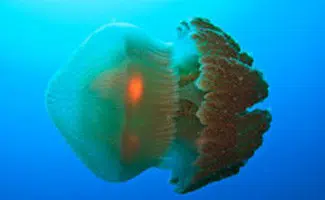When you purchase through links on our site, we may earn a commission. Here’s how it works.

The Box Jellyfish
Certain species of the box jellyfish are recognized for the incredible strength of their venom, these species include the Carukia barnesi, the Chironex fleckeri and Malo kingi. Box jellyfish are actually not as box shaped as their name implies, in fact these jellyfish are umbrella shaped and can move at extremely rapid paces. Box jellyfish are for the most part concentrated in the Indo-Pacific but they can also be found in the Atlantic, the Mediterranean and the east Pacific. Not all species of the box jellyfish inflict fatal stings, in fact even some known to give fatal stings are not always fatal. The most commonly recognized box jellyfish species in terms of fatal stings is the Chironex fleckeri of Australia which has extremely potent neurotoxic venom that in injected from cnidocytes on the tentacles. Each tentacle of the box jellyfish can hold as many as 500,000 cnidocytes. The sting of the box jellyfish attacks the nervous system and causes shock and many times heart failure, anti-venom does exist but must be administered in a timely manner after the initial sting. Although the Chironex fleckeri is known for having extremely potent venom the reported number of deaths as a result of stings from this jellyfish total 64 since the first reported fatality in 1883. While 64 may not seem like a significantly large number, it is not the number of deaths caused by an animal that make it one of the most poisonous animals in the world, instead it is the power of the venom injected at the time of attack.
Most Poisonous Animals Video: The Box Jelly Fish [Video]
https://www.youtube.com/watch?v=xDFANVXCtcY
The Cone Snail
The cone snail is generally not mentioned by anyone as being one of the most poisonous animals in the world, namely because it is a snail and no one ever thinks of snails as having venom let alone venom strong enough to kill its victim. The cone snail is native to the Indo-Pacific Ocean where it lives and feeds on the ocean floor. The cone snail feeds on small fish and utilizes a harpoon laced with poison to stun prey before consuming them. While these small snails may seem rather unassuming the fact is that if one of the larger species of these snails were to harpoon you and inject you with its poison, the sting can be fatal. The venom of the cone snail causes muscle paralysis, respiratory failure, and on occasion, death. There is currently no antidote for cone snail venom and the only method of treatment at this time is to keep the victim stable with life support until the snail venom has been completely metabolized. Ironically at this time medical research is looking in to the use of cone snail venom as a substitute for morphine due to its ability to decrease heart rate and deactivate pain receptors.
The Inland Taipan
The inland Taipan is noted as being the world’s deadliest snake. This snake of the Oxyuranus genus is a named as a fierce species of snake native to Australia. Despite being named a “fierce” snake, the inland Taipan is not actually aggressive and much prefers to escape danger than to confront it, the term fierce related to the fierce nature of the venom of this deadly snake. The inland Taipan is a dark tan to dark olive green color and generally measures around 6 feet in length. A single bite from this snake results in death of its prey and this includes human beings although humans are not seen as a prey item, merely as a threat. When picked up or threatened when the inland Taipan sees no other means of escape it will bite and inject a human with an average of 44 mg of the venom taipoxin neurotoxin. The most ever venom noted as being injected by a single snake of this species is 110 mg, the median lethal dose of venom for mice is 30 μg/kg (ppb.) All known victims of bites from the inland Taipan have been herpetologists studying the snake to more accurately understand it, all of these bite incidents were treated successfully with anti-venom.
The Deathstalker Scorpion

The Stone Fish
When it comes to the most poisonous animals on the planet very few people think of fish. As it happens however, one of the most poisonous animals in the world is the stone fish. The stone fish is native to the Indo-Pacific Ocean around coastal regions and is colored to camouflage itself among stones, hence the name stone fish. The poison within these fish lies in neurotoxins that are released from glands at the bottom of the needle-like dorsal spines of this fish that are raised as a means of defense when the fish is threatened. Most commonly envenomation by the stone fish occurs when individuals accidentally mistake this fish for a stone and step on it. The venom of the stone fish can prove to be fatal within two hours of the initial sting. Treatment for a stone fish sting includes the administration of anti-venom in addition to the application of extremely hot water (113 degrees Fahrenheit) which has proven in most cases to destroy the venom.
The Brazilian Wandering Spider
One creature that many people expect to see on the list of the world’s most poisonous animals is the spider but contrary to popular belief the world’s most poisonous spider is not the black widow. The Brazilian wandering spider is most commonly found living in banana plantations in Brazil. The Brazilian wandering spider is not only recognized for the potency of its venom but also for its aggressive nature. This spider can have a leg span of up to 4 to 5 inches and a body length of 1 to 2 inches and have been known to both hiss and draw up their front legs to expose their fangs before initiating a powerful bite. The wandering spider gets its name from the fact that rather than building webs these spiders wader around the floors of Central and South American forest floors. The neurotoxin in the venom of the Brazilian wandering spider is particularly potent and produces loss of muscle control, respiratory failure, paralysis and on occasion death. Depending upon the amount of venom injected with a single bite and the age and demographics of the bite victim anti-venom is required to treat a bite from the Brazilian wandering spider.
The Greater Blue Ringed Octopus
The greater blue ringed octopus is recognized by a large number of individuals as being one of the most poisonous animals in the world. Native to the Pacific Ocean this octopus grows to 8 inches across and is most commonly brown and yellow in color, only revealing its blue rings when threatened or attacking prey items. The blue ringed octopus can be found in coral and rock pools in the Pacific Ocean where it feeds upon shrimp, mollusks, fish and crabs which it incapacitates with venom injected using its beak. The venom of the blue ringed octopus is secreted from glands near to the mouth and injected when the prey is pierced using the sharp strong beak. This species of octopus, while known as one of the world’s most venomous creatures, is actually particularly calm unless it feels threatened at which point it flashes its blue rings before latching on to prey. Occasionally human beings are bitten by these octopi and the toxic neurotoxins that are injected can easily kill their victim. The toxin of this octopus is similar to a neurotoxin that is also found in the cone snail and the puffer fish. Unfortunately for those bitten by the greater blue ringed octopus there is not currently any anti-venom that can be used to treat the bite of this octopus. A bite from the blue ringed octopus causes motor paralysis, respiratory arrest and cardiac arrest. Treatment for a bite from this octopus involves maintaining artificial respiration for the victim until the paralysis effect of the venom has passed, which usually occurs within two hours. Without artificial respiration however; a fully grown human male can suffer from respiratory failure and death.
The Harvester Ant
The harvester ant may seem like a particularly small and unassuming creature, but this insect actually does make it on to the list of the world’s most poisonous creatures. Most commonly harvester ants are found in the southern United States, particularly in New Mexico and Arizona where the live in incredible ant hills which can hold more than 10,000 ants. Some harvester ant mounds have been discovered that measure more than 6 ½ feet deep in to the ground and 3 ½ feet above the ground. Of all species of harvester ant the Maricopa harvester ant or Pogonomyrmex Maricopa is the single most poisonous and is actually recognized as being the most poisonous insect in the world. The Maricopa harvester ant measures approximately half an inch to one and a quarter inches long but the venom of these ants is so strong that just twelve stings can kill a four and a half pound rat. The intense strength of the harvester ant toxin is so strong that in comparison to the honey bee it is twenty times the strength. One of the most dangerous aspects of the harvester ant sting is that once the toxin is released it leaves a pheromone trail that attracts other ants that flock to the sting site to attack the threat. With colonies that are made up of some 10,000 individuals the number of bites from a single harvester ant attack can be phenomenal. The sting of this ant is rather painful; however, anaphylaxis can occur and cause death as a result of a reaction to the ant’s apitoxin injection in to the bite site.
Want to learn more about the harvester ant? We’ve got an entire article that delves deeper into the harvester ant for you to enjoy. You can jump over to our harvester ant article now, or bookmark it to read when you’re finished this one.
The King Cobra
The king cobra is one creature that many people expect to find on the list of the world’s most poisonous animals. Not only is the king cobra an exceptionally venomous snake, but it is also the longest venomous snake in the world measuring in at over 18 ½ feet long. The king cobra is found most commonly living in the forest regions of India, the Philippines, Indonesia and Southeast Asia. This particular cobra is exceptionally aggressive and is also extremely venomous based on the sheer amount of venom that is injected with a single bite. Certainly the venom injected by the inland Taipan is considered to be much stronger than that of the king cobra but this snake issues such an amazing amount of venom with a single bite that it can easily kill a fully grown man. One of the most astounding facts about the venom of the king cobra is that this snake can kill a fully grown Asian elephant with a single bite to the trunk, death occurs generally within three hours. The venom of this highly toxic snake incorporates both neurotoxins and cardiotoxic compounds and once they take effect they result in an attack on the victim’s central nervous system which can result in paralysis, coma and death by respiratory failure. One bite to a healthy adult male by the king cobra can result in death in just fifteen minutes but death may take as long as forty five minutes. The mortality rate of a king cobra bite is around 75 % but fortunately there are two varieties of anti-venom available to treat a bite by a king cobra. Unfortunately for those bitten, the anti-venom that is available is not available in significant quantities and is only manufactured in two specific locations in the world. If an individual is bitten by a king cobra and anti-venom is administered within a particularly short time frame, the effects of the snake venom can be remedied within approximately seven hours after envenomation.
The Poison Dart Frog

Most Poisonous Animals Video: The Poison Dart Frog [BBC Video]
Featured in this clip from the BBC wildlife show Wild Caribbean are some of the world’s most colorful and deadly frogs.
Why Are So Many Species Of Animal So Poisonous?
Why are so many species of animals so incredibly poisonous? For a number of animals the strength of their poison is a result of evolution. Animals that live in a particularly dangerous environment are exposed to more dangers in their every day interactions and as a result they have developed extreme poisons that are able to help them to survive. For other animals their development of such strong poisons is a result of their small size and inability to otherwise overcome prey items, for example the Deathstalker scorpion that relies upon the strength of its venom to bring down large insects. Without their incredibly strong and unusual venoms many of these animals would have been unable to survive life in the intense habitats that they call home and would have succumbed to larger predators that tend to dominate the tropical climates that house so many of these species.
More Highly Poisonous Animals
Added on March 25, 2012
The Black Mamba

The Sydney Funnel Web Spider
The Sydney funnel web spider is so named because it is a funnel web spider that is found within a sixty two mile radius of Sydney, Australia. This venomous spider varies in size and can measure in at anywhere from .39 inches to 2 inches long. This funnel web spider is black in color and is sexually dimorphic in that the males of the species are smaller and have longer legs than the females. This spider is a terrestrial spider that builds tunnels that have a funneled entrance which has a trapdoor or a series of trip lines designed to capture prey as they walk past. Most commonly these poisonous spiders are found in humid climates and make their burrows in trees, under rocks or in sandy ground. Most often these spiders feed upon small lizards and frogs or insects that pass by the burrow and become ensnared in trip lines or simply fall in to the trapdoor. When prey passes the funnel web spiders burrow, the spider leaps from its burrow and bites its prey envenomating them. This spider species is quite aggressive and with bite repeatedly when threatened. The venom of this toxic spider contains atracotoxin which acts upon the nervous system. While the venom of this spider is deadly to humans – particularly young children and the elderly, there is an anti venom that has prevented any fatalities since 1981.
The Puffer Fish
There are a number of puffer fish species with approximately one hundred and twenty species found within nineteen different genera. The puffer fish is known by a variety of different names including: balloonfish, blowfish, swellfish and puffers. It is commonly said that these vertebrates are the second most poisonous vertebrates in the world. The puffer fish species can most often be spotted in tropical waters where the temperatures are much warmer, conversely, these fish are not found in cool waters. There are a number of areas of this fish that are considered to be extremely toxic such as the skin, the liver and other internal organs. Unusually for a particularly poisonous animal, the puffer fish is considered to be a delicacy in Japan and is commonly eaten. If served improperly this fish can be lethal which begins with a slight intoxication and can result in death by paralysis. Puffer fish poisoning is caused by eating incorrectly prepared fish and causes light headedness, vomiting, numbness, rapid breathing, rapid heart rate, a sudden drop in blood pressure and finally muscle paralysis. The muscle paralysis that comes from puffer fish poisoning will eventually paralyze the diaphragm and prevent breathing. It is possible for individuals to survive puffer fish poisoning; however, individuals can often be thrust in to a coma for a number of days prior to recovery. The poison of the puffer fish is not believed to be produced by the fish itself, it is believed to be a product of the stomach contents of the shellfish that the puffer fish feed upon.
The Carpet Viper
The carpet viper is also known as the saw scaled viper and the echis. These extremely poisonous snakes are native to Sri Lanka, Pakistan, India, Africa and the Middle East. There are currently eight species of this venomous snake known and they are all found in extremely dry conditions. The carpet viper is known for being the snake species that is responsible for the most snake bites and the most deaths due to snake bites in the world. The adult carpet viper measures in at around thirty five inches in length and is a dark brown green in color with serrated keels on the scales. This poisonous snake species is known for the strange noise that it makes when threatened which sounds much like sizzling bacon caused by the snake rubbing its coils together. This snake can be aggressive when cornered and when their noisy threat is ignored. Most commonly these species are believed to feed upon insects, spiders, frogs, other snakes, birds, small mammals and other reptiles. The venom of the carpet viper contains hemotoxins which can cause bleeding throughout various parts of the body that can last for days to weeks. As the hemotoxins take effect it is possible for bleeding to occur within the brain and cause death, in most cases of bites that are not treated intracranial bleeding does occur. The actual potency of the carpet viper’s venom varies depending upon the individual snake species as well as the sex of the snake and the time of the year.
Irukandji
Added on June 6, 2012
The irukandji jellyfish is a very tiny but very poisonous jellyfish that is found in the waters of Australia, the British Isles, Florida and Japan. There are two recognized species of this tiny jellyfish, the Carukia barnesi and the Malo kingi. The body of the irukandji is around .2 inches to .4 inches wide and they have four tentacles that can grow to as long as 3.3 feet! The stingers of this jellyfish are located around the body as well as along the tentacles and look like tiny red dots. When the irukandji attacks it fires stingers directly in to prey items and the victim soon begins to present with symptoms. The symptoms associated with irukandji are referred to as “irukandji syndrome” and include: excruciating pain, muscle cramps, burning of the skin, nausea, sweating, vomiting, restlessness, an increase in blood pressure and an increase in heart rate. While the length of symptoms can vary, the majority of irukandji sting victims require hospitalization. While for the most part, single irukandji stings are not fatal to man when treated promptly, fatalities have been recorded.
Red Back Spider
The red back spider is often confused with the black widow spider, while related; the red back spider is endemic to Australia while the black widow is found in North America among other areas. The red back spider has a similar appearance, with a rounded abdomen, an all black body and a red marking on the upper abdomen. The red stripe runs down the length of the spider’s body and on the underneath of the spider it takes on the appearance of an hourglass shape. While the female red back spider is black and red, the male of the species is light brown with white coloration. Red back spiders are a particularly fast moving species and can survive in a wide variation of temperatures. The red back spider bites its prey and injects venom through hollow fangs. The venom of this spider contains the neurotoxin alpha-latrotoxin which causes the release of numerous neurotransmitters in the brain and causes damage to red blood cells. Throughout history only 14 deaths have been attributed to red back spider envenomation. Since the introduction of antivenin, red back spider bite fatalities have disappeared but the neurotoxins in the venom still pose a considerable risk to those with compromised or underdeveloped immune systems.
Tiger Snake
Tiger snakes are another poisonous creature native to Australia as well as Tasmania. This venomous snake is so named because of the tiger like stripes that run across its body. A member of the Elapidae family, this snake can reach as long as 7 feet and can be fatal to humans. The color of the tiger snake tends to vary considerably from region to region but the most common colors include: yellow, orange brown, black and olive. The tiger snake prefers to live in coastal areas where they have access to both water and large prey populations. The venom of the tiger snake contains coagulants, neurotoxins, myotoxins and haemolysins. Symptoms from a tiger snake bite can include: trouble breathing, sweating, pain in the neck and feet, numbness, tingling and paralysis. The mortality of untreated bites from this snake falls between 40 and 60%.
Gila monster
The Gila monster is a venomous lizard found throughout Sonora, Mexico and in the southwestern United States. This long lizard can grow to 2 feet long and while its venom is particularly dangerous the slow speed of this “monster” makes it little threat to adult humans. The Gila monster spends most of its time living in burrows of small mammals and they crush and swallow their prey. This venomous lizard only feeds a handful of times per year. When the Gila monster does feed it injects prey through chewing prey items since it does not have the ability to inject via fangs as many snakes do. The salivary glands of the Gila monster produce the venom which is then expressed through the teeth and in to chewing wounds. The venom of this lizard contains neurotoxins and no confirmed human fatalities have been made recorded in over 80 years. With that said however, a bite from a Gila monster can cause death in those with compromised immune systems. Symptoms associated with a Gila bite include: pain, weakness, a rapid drop in blood pressure, lethargy, paralysis and even hypothermia. Ironically, while the venom of this lizard is considered to be poisonous to humans, it has also been proven to inhibit the growth of lung cancer.
Boomslang
The boomslang is a venomous snake native to sub-Saharan Africa. This long snake tends to grow to between 3 and 5 feet long, but some individuals have been recorded as long as 6 feet! While the color of the boomslang varies considerably, all snakes within this species have an egg shaped head with very large eyes. These large eyes are conducive to excellent eyesight which helps them to spot prey in trees. The boomslang is an arboreal snake and has been known to hibernate. Unlike many other venomous snakes, the boomslang is not overly aggressive and attacks only when they feel threatened or cornered, they would much rather escape conflict. The venom of the boomslang is exceptionally potent and is injected through rear fangs. The main devastation from a boomslang bite results from the hemotoxins properties. A bite from a boomslang may not show immediate symptoms because it is slow acting venom, however, if left untreated the victim will often die from internal and external bleeding. Other symptoms associated with the bite of this snake include: severe drowsiness, mental disorders, headache and nausea. If not treated quickly enough, the victim of a boomslang bite may require a blood transfusion in order to cleanse the hemotoxins from the blood.
Komodo dragon



